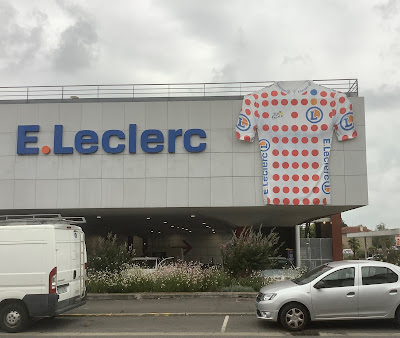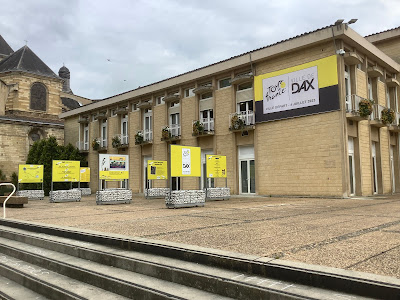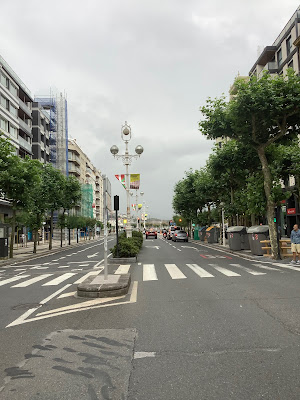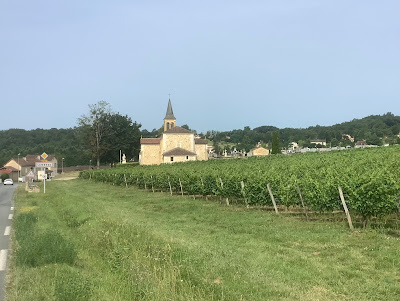
As I sat in the jam-packed Atlanta airport awaiting the second leg of my ten-hour flight to Paris, I was struck by the thought that I was going a long way for a bike ride. It was no ordinary ride, following the Tour de France, but I’d already done it a few times before, seventeen in fact, so I hardly needed to do it again.
But, oh yes, I did need to do it again. It was most surely in my blood. Biking around France in July, tagging along with The Tour, is the ultimate of bike rides. Biking through the French countryside is second to no place else and to do it when the entire country’s focus is on the bicycle and on The Tour, it is worth any sacrifice, though there was the present morally questionable act of flying in these times of the atmosphere filling with pollutants that may end life as we know it.
My fellow passengers may have had better justification than going for a bike ride for taking to the air, but I did not raise the question with any of them as I closed my eyes upon taking my seat, as it was midnight and I was ready for sleep. Fortunately, Ralph Nader hasn’t gotten Congress to pass a law making it so mandatory for passengers to wear a seat belt, as he did with automobiles, that an alarm sounds whenever someone doesn’t have their seatbelt fastened, as I noticed through my entire row no one was quick about putting theirs on. If a beep had sounded when the plane began to roll for all that were unfastened, it would have been mayhem with shouts all round, “who doesn’t have their seat belt fastened.”
I was surprised upon arrival in Paris the vast majority on my flight went through the transfer portal rather than baggage retrieval. A goodly number were likely headed to Africa, but it was difficult to surmise about the others. Charles de Gaulle airport was much quieter than Atlanta, the least busy I’ve ever seen it. And understaffed. The French are trying to discourage air travel with all shorter routes within the country that can be reached by train curtailed.
There was no line for getting by passport stamped with so few arriving, but it was an hour before our baggage arrived. There were only two representatives at the Air France customer service. In the past each of the eight stations had been staffed. I stopped to make sure Air France still provided bike boxes for those traveling with a bike, the reason Air France is my choice. Thankfully it still does, sparing me the major hassle of coming up with a bike for my flight home.
With that weight off my shoulders I could get on my bike and disappear into France. It was 4:30. I had better than five hours of light to escape fhe sprawl of Paris and defeat jet lag and find a place to camp. I was immediately energized as I slipped into the procession of cars leaving the airport. They were virtually all compacts, not a SUV among them. What a joy. Gas going for eight dollars a gallon could be a contributing factor.
As always, I had to adjust my reflexes, as the French like to accelerate fast and dart quickly in front of me making turns or entering the highway. The rush hour traffic was thick and congested, allowing me to ride past backed up cars at certain points. And I had the pleasure of one round about after another. There’s only one anywhere near me in Chicago, five miles away in Brookfield, though it’s not a free-flowing roundabout, as each entry has a stop sign, rather than the standard yield sign, as the locals couldn’t adapt to the ease of slipping in and out without having to come to a halt.
It was thirty miles, mostly west, to Orly Airport before I could head south and out of the metropolitan sprawl into the countryside towards Moulins, two hundred miles away, where I would pick up the Tour route and follow it from there to its starting point in Bilboa, Spain, a further five hundred miles. I rode National Highway 7 for a few miles past the airport, then turned off onto a quiet rural road and had a campsite in a forest in no time. Camping doesn’t come any easier than in France with its abundance of forests everywhere.
I was well fed by Air France, a dinner shortly after takeoff and breakfast shortly before landing, and had some leftovers, so I didn’t need to eat much and could get to sleep. The forest was dark enough that the morning light didn’t wake me, but rather the patter of rain. I didn’t mind sleeping in. After eleven hours of sleep the rain had diminished enough to break camp.
The light rain barely wetted my shoes and socks, so I had no complaints. It wasn’t long before I came to a cemetery and could fill my water bottles and salute Yvon for telling me this secret many years ago when we met at the Chapel des Cyclists. I often wonder if I would have ever discovered this easy source of water, as cemeteries in the US, which occasionally provide camping for me, don’t offer such an amenity. I wouldn’t have been drawn to French cemeteries as they are very compact and nothing but hard surface with no grass.

I am always so happy for the water I express my gratitude by filling whatever receptacles are by spigot, often several, for those venturing to the cemetery to wash the grave of whom ever they are visiting. It has to please the visitors to be able to immediately grab a can and tend to their business. If they’re in the sun, they’ll be heated to make the washing all the easier. It’s a gesture I don’t find repeated, so I have yet to establish a trend, just as I’m not establishing much of a trend of getting people on bikes.
My next noteworthy stop was the supermarket. Though I wasn’t desperate for food I was eager for a bottle of mint syrup to enliven the water in my water bottle. Others may be drawn to France for its wine, but for me the greatest drinking pleasure anywhere is this zesty mint drink—menthe á l’eau. Each sip dazzles my throat and alleviates whatever concerns I may have. I am happy to take a hit every few minutes as I’m pedaling along.
Along with the sirop de menthe I bought another of my French staples, a pound of couscous, and also half a pound of pâté and a baguette, thoroughly Frenchifying myself. I was sorry to discover that inflation has not spared France, as everything was at least twenty-five per cent higher than two years ago. I definitely knew I was in France when a little ways down the road I came upon a car pulled off the road and a man standing in the bushes with his back to the road taking a pipi rustique. Nowhere else are men so casual about answering nature’s call.I needed another eleven hours of sleep on night two, but was fine with eight hours the next night, allowing me to arrive in Moulins by mid-morning. There were signs on the outskirts announcing the arrival of The Tour and banners and flags and billboards all over advertising the Tour, each conveying a jolt of joy that The Tour was nigh.
It would start a week from today and reach Moulins twelve days later. It was the first time Moulins had hosted The Tour. It had been the only prefecture of the ninety-five départements never to have been a Ville Étape, so it is an especially noteworthy event for the town and for The Tour completing the roster of all the prefectures. The town tower was adorned with the three prominent jerseys of the peloton. And the town hall across the street was similarly adorned.
I will now head west on the roads that the peloton will ride entering Moulins, making a sharp right after it crosses the L’Allier river, then finishing a mile further beside a small park. It will be an especially memorable finish, as I will be joined by Florence and Rachid, who will be driving down from Tours for our almost annual rendezvous.



































